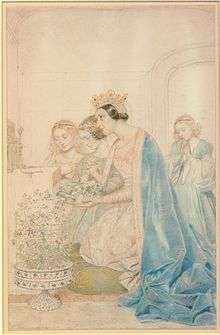Saint Amelia, Queen of Hungary

Saint Amelia, Queen of Hungary is an oil painting by Paul Delaroche which was investigated in 2016 by the BBC TV programme Fake or Fortune?
Lost work
An oil painting of Saint Amelia by history painter Paul Delaroche was commissioned in 1831 by Queen Marie-Amélie of France, wife of King Louis Philippe.[1] It was created as a design for a stained glass window in the Queen's private chapel at the Château d'Eu. The work was exhibited at the Salon of 1834. In 1837 the painting was recorded as being hung in the Royal Chapel at the Tuileries Palace in Paris, and was copied in an engraving by Paolo Mercuri.[2] A preparatory drawing, in chalk, graphite and watercolour is held by the British Museum.[3] The original painting was believed to be lost.[4]
Fake or Fortune?
The Fake or Fortune? team investigated a version of the painting, housed at Castle of Park in Cornhill, Aberdeenshire, to determine whether it was the Delaroche original or one of a number of copies. This unsigned version of the painting, was bought in 1989, for about £500, by art dealer the late Neil Wilson, who worked for Christie's after leaving university. The painting's provenance was very poor. In the programme, art expert Bendor Grosvenor showed an 1866 watercolour by Joseph Nash depicting the painting in the Queen's bedroom at Claremont House in Surrey, where the King and Queen lived after fleeing France following the Revolution of 1848. After that, the next sighting of the work was when it was sold at Christie's in 1980 as a work by the French artist Fleury François Richard, with the title 'A Queen and her Retinue at Worship'.[5]
Technical analysis showed that colour anomalies in the painting were the result of pigment degradation, and that parts of the painting had also been restored. After reviewing the show's findings, Professor Stephen Bann, a leading Delaroche expert, concluded that it was the lost original. He also revealed a letter written by Delaroche, in which registers his dismay at the state of the picture after it had been copied to create a stained glass window for Queen Marie-Amélie, and says that he will have to do considerable work to restore it.[6] Following its authentication, Wilson's widow, Becky, was reported to have decided to keep the painting, but allow it to be displayed at the British Museum in London when a Delaroche exhibition takes place.[7]
References
- ↑ "Raunheim, Hermann (1817-1895) - Saint Amélie, Queen of Hungary". www.royalcollection.org.uk. Retrieved 10 July 2017.
- ↑ "Mercuri, Paolo (1804-1884) - Sainte Amélie, Queen of Hungary". www.royalcollection.org.uk. Retrieved 10 July 2017.
- ↑ "drawing". British Museum. Retrieved 10 July 2017.
- ↑ Bann, Stephen (1997). Paul Delaroche: History Painted. Reaktian Books. p. 165.
- ↑ Grosvenor, Bendor (2016-07-22). "'Fake or Fortune?' does Delaroche". Art History News. Retrieved 10 July 2017.
- ↑ Muñoz-Alonso, Lorena (2016-07-25). "Long-Lost Panting by French Master Paul Delaroche Authenticated on TV Show". artnet News. Artnet Worldwide Corporation. Retrieved 10 July 2017.
- ↑ Davidson, Peter (2016-07-26). "Late North-East Art Dealer's £500 Artwork Revealed to be Rare Masterpiece". Evening Express (Aberdeen). Retrieved 10 July 2017.
External links
- Fake of Fortune: Delaroche at bbc.co.uk